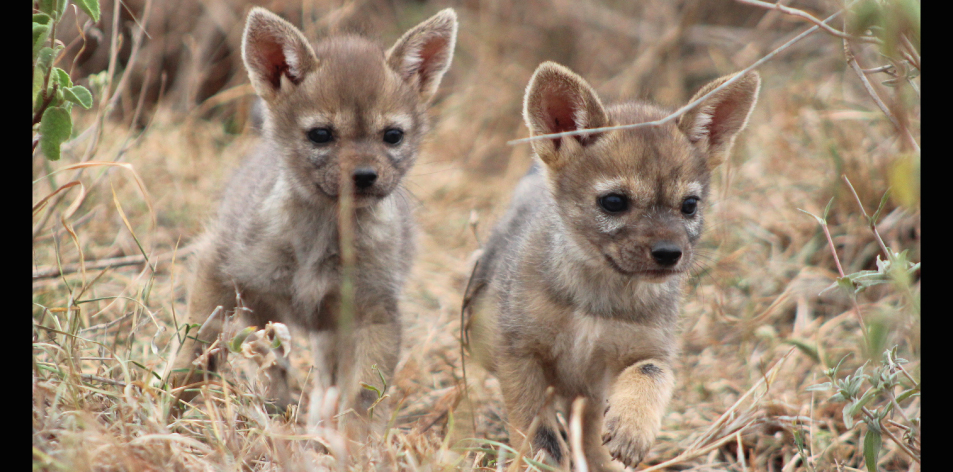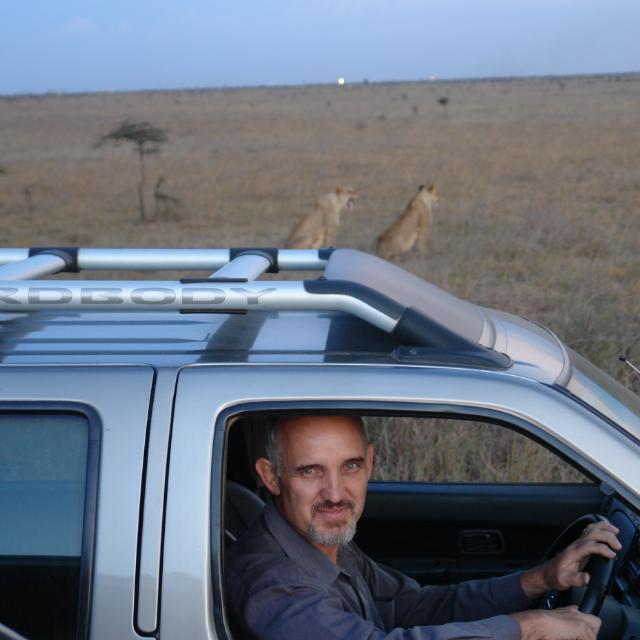
Packs And Pups!! – Article by Gareth Jones
NAIROBI NATIONAL PARK – PACKS AND PUPS!! – By GARETH JONES
Early one cool morning we entered the East gate and drove towards the middle of the park. Soon I saw a movement next to the road near No 6 junction, it was a black-backed jackal. Then I noticed something much smaller moving in the long grass on the opposite side of the road. We were excited to find that the smaller creatures were, in fact, cute little jackal pups. Wow! what a sighting! At first, they were seemly scared of the vehicle and quickly disappeared into their burrow. We decided to wait and see if they would come out again. After sitting quietly for about 15 minutes we were rewarded as they slowly emerged. First, a single head appeared, then another, and another as they peered in our direction as if wondering what the strange shiny silver object was. We continued to sit quietly and soon 6 pups emerged and began to act more naturally as the played games around the burrow, like “catch it if you can” and “bite the stick”. Two of the pups were quite quizzy and came quite close to our vehicle. It was really a privilege to be able to watch them for a while, as the adult black-back jackals watched us with suspicion from the nearby bushes.
Black-backed jackals not often seen in the park, so having such sightings of a pack of black-backed jackals with pups is very rare and proves that they are in fact recovering as a species in the park. They are opportunistic in nature and will eat carrion or even hunt small insects, birds and mammals. I once witnessed a jackal try to catch a wildebeest calf that had been separated from its mother, but thankfully the calf escaped.
The black-backed jackal (Canis mesomelas) is a canid native to two areas of Africa, separated by roughly 900 km. One region includes the southernmost tip of the continent, including South Africa, Namibia, Botswana, and Zimbabwe in which the subspecies Canis mesomelas occurs. The other area is along the eastern coastline, including Kenya, Somalia, Djibouti, Eritrea and Ethiopia in which the subspecies Canis mesomelas schmidti occurs predominantly in wild areas away from towns and cities. The black-backed jackal is a fox-like canid with a slender body, long legs and large ears. It is similar to the closely related side-striped jackal and more distantly related to the golden jackal, though its skull and dentition are more robust and the incisors much sharper. It weighs 6–13 kg, stands 38–48 cm at the shoulder, and measures 67.3–81.2 cm in body length. It is listed by the IUCN as least concern, due to its widespread range and adaptability, although it is still persecuted as a livestock predator and rabies vector. The black-backed jackal is a monogamous and territorial animal, whose social organisation greatly resembles that of the golden jackal. However, the assistance of elder offspring in helping raise the pups of their parents has a greater bearing on pup survival rates than in the latter species.
The mating season takes place from late May to August, with a gestation period of 60 days. Pups are born from July to October. Summer births are thought to be timed to coincide with population peaks of rodent species, while winter births are timed for ungulate calving seasons. Litters consist of one to 9 pups, which are born blind. For the first three weeks of their lives, the pups are kept under constant surveillance by their dam, while the sire and elder offspring provide food. The pups open their eyes after 8–10 days and emerge from the den at the age of 3 weeks. They are weaned at 8–9 weeks and can hunt by themselves at the age of 6 months. Sexual maturity is attained at 11 months, though few black-backed jackals reproduce in their first year. Black-backed jackal pups become increasingly quarrelsome as they age, and establish more rigid dominance hierarchies. Dominant pups appropriate food and become independent at an earlier age. The grown pups may disperse at one year of age, though some remain in their den territories to assist their parents in raising the next generation of pups. The average lifespan in the wild is 7 years, though captive specimens can live twice as long.
There is always something interesting or fascinating to see when looking at the wonderful creations of God, so why spend some restful time in the Nairobi National Park? You never know what you might see and experience!!!
The park is open daily from 06h00 to 19h00.
Gallery


